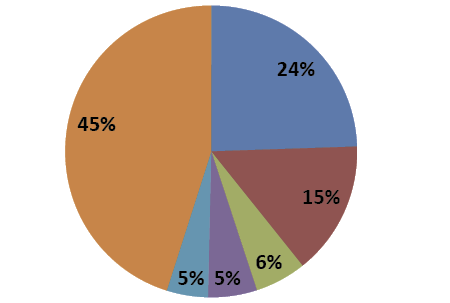Magazine: Office in your pocket
Smartphones are conquering the world. According to the Ericsson Mobility Report (published this February), last year 1.3 billion were sold worldwide. It took 5 years for the number of smartphone subscriptions to reach 1 billion by 2012, but for the second billion 2 years were enough.
 By 2016 there will be more smartphones than plain mobile phones. In 2014 behind 40 percent of all mobile subscriptions there was a smartphone. As for Hungary, 39 percent of mobiles used are smartphones and in one year their number grew by 10 percentage points. At world level more than 80 percent of smartphones are running on Android. The second most popular operating system is Apple’s iOS with a 14.8-percent market share; Windows phones are at 2.7 percent. Communications expert Nelli Kadlok told our magazine that 8 from 10 subscribers buy a smartphone at Telenor and Android devices are the most popular choice. Orsolya Nyilas, the head of internal communications at Samsung informed our magazine that on 17 April the Samsung S6 and S6 Edge came out: these are the flagship products of the company and they hope that the curved design will attract many people – 5 million consumers pre-ordered the new smartphone already. However, it was LG who first came out with a curved-screen phone, LG G Flex in 2014, followed by G Flex 2 in 2015. We learned from Beáta Kónya, regional PR specialist of LG Electronics Magyar Kft. that the latest LG smartphone, LG G4 debuts in the Hungarian market when the present issue of Trade magazine goes to press. A slightly curved screen, an exclusive back cover and a top-notch camera characterise the new device. András Mihály Tóth, the head of Microsoft Magyarország’s Windows business line told us that they had just put the Microsoft Lumia 640 and Lumia 640 XL smartphones on the market. These devices come with Office 365 Personal subscription, 60 minutes of free Skype a month and 1 terabyte of OneDrive online storage space until the end of June. Chinese company Huawei only manufactures smartphones and in Hungary their market share was 5.7 percent in Q1 2015 – revealed Amarilla Ament, marketing manager of the company. In 2014 Huawei managed to improve medium- and high-category deliveries by 18 percent at world level. In Hungary their most popular smartphones are P7, G620, Y330 and Y550. Smartphones are basically miniature computers, so the Bring Your Own Device (BYOD) trend of using them in work is spreading all over the world. Ms Nyilas reckons this trend is very new to Hungary, used only by few companies. Still, their survey found that on the smartphone of an average employee there are 10 personal and 8 work-related apps. Microsoft Hungary’s experience is the popularity of BYOD is growing and an Ipsos MORI survey conducted among SMEs revealed that 25 percent of employees use their own smartphones in work. Telenor informed us that as part of the BYOD trend SMEs often only buy SIM cards with their subscriptions and employees use them in their own smartphones. Ms Ament opines that BYOD is the office of the future and with the proliferation of mobile internet subscriptions more and more companies will use it. From Telenor’s services for smartphone cloud-based solutions are the most popular. For instance SMEs can profit from an Office 365 subscription as they get full office software pack and one terabyte of free storage. Smartphone use for corporate purposes also raises security concerns, e.g. one can lose their phone with important company data on it. Samsung developed KNOX, a mobile enterprises security solution that makes it possible for users to switch between password-protected private and corporate applications on the same device. John Suffolk, Huawei’s global head of cybersecurity opines it is a big problem that many companies connect high-level digital safety systems to unreliable company networks. The result is corporate IT systems which pose many risks and are unable to guarantee data security. What is more, this situation is also frustrating for those who would like to introduce next-generation mobility and cloud-based technologies at company level.
By 2016 there will be more smartphones than plain mobile phones. In 2014 behind 40 percent of all mobile subscriptions there was a smartphone. As for Hungary, 39 percent of mobiles used are smartphones and in one year their number grew by 10 percentage points. At world level more than 80 percent of smartphones are running on Android. The second most popular operating system is Apple’s iOS with a 14.8-percent market share; Windows phones are at 2.7 percent. Communications expert Nelli Kadlok told our magazine that 8 from 10 subscribers buy a smartphone at Telenor and Android devices are the most popular choice. Orsolya Nyilas, the head of internal communications at Samsung informed our magazine that on 17 April the Samsung S6 and S6 Edge came out: these are the flagship products of the company and they hope that the curved design will attract many people – 5 million consumers pre-ordered the new smartphone already. However, it was LG who first came out with a curved-screen phone, LG G Flex in 2014, followed by G Flex 2 in 2015. We learned from Beáta Kónya, regional PR specialist of LG Electronics Magyar Kft. that the latest LG smartphone, LG G4 debuts in the Hungarian market when the present issue of Trade magazine goes to press. A slightly curved screen, an exclusive back cover and a top-notch camera characterise the new device. András Mihály Tóth, the head of Microsoft Magyarország’s Windows business line told us that they had just put the Microsoft Lumia 640 and Lumia 640 XL smartphones on the market. These devices come with Office 365 Personal subscription, 60 minutes of free Skype a month and 1 terabyte of OneDrive online storage space until the end of June. Chinese company Huawei only manufactures smartphones and in Hungary their market share was 5.7 percent in Q1 2015 – revealed Amarilla Ament, marketing manager of the company. In 2014 Huawei managed to improve medium- and high-category deliveries by 18 percent at world level. In Hungary their most popular smartphones are P7, G620, Y330 and Y550. Smartphones are basically miniature computers, so the Bring Your Own Device (BYOD) trend of using them in work is spreading all over the world. Ms Nyilas reckons this trend is very new to Hungary, used only by few companies. Still, their survey found that on the smartphone of an average employee there are 10 personal and 8 work-related apps. Microsoft Hungary’s experience is the popularity of BYOD is growing and an Ipsos MORI survey conducted among SMEs revealed that 25 percent of employees use their own smartphones in work. Telenor informed us that as part of the BYOD trend SMEs often only buy SIM cards with their subscriptions and employees use them in their own smartphones. Ms Ament opines that BYOD is the office of the future and with the proliferation of mobile internet subscriptions more and more companies will use it. From Telenor’s services for smartphone cloud-based solutions are the most popular. For instance SMEs can profit from an Office 365 subscription as they get full office software pack and one terabyte of free storage. Smartphone use for corporate purposes also raises security concerns, e.g. one can lose their phone with important company data on it. Samsung developed KNOX, a mobile enterprises security solution that makes it possible for users to switch between password-protected private and corporate applications on the same device. John Suffolk, Huawei’s global head of cybersecurity opines it is a big problem that many companies connect high-level digital safety systems to unreliable company networks. The result is corporate IT systems which pose many risks and are unable to guarantee data security. What is more, this situation is also frustrating for those who would like to introduce next-generation mobility and cloud-based technologies at company level.
Related news
Related news
WHO: They urge a 50 percent price increase for tobacco, alcohol and sugary drinks
The World Health Organization (WHO) is calling for the prices…
Read more >Eurozone economic growth accelerated in June
The eurozone’s economic performance accelerated in June, according to the…
Read more >This is how drug prices are changing: the government introduced price restrictions
The Ministry of National Economy’s price restrictions on medicines came…
Read more >



